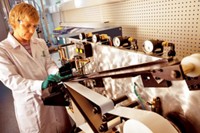Advertisement
Grab your lab coat. Let's get started
Welcome!
Welcome!
Create an account below to get 6 C&EN articles per month, receive newsletters and more - all free.
It seems this is your first time logging in online. Please enter the following information to continue.
As an ACS member you automatically get access to this site. All we need is few more details to create your reading experience.
Not you? Sign in with a different account.
Not you? Sign in with a different account.
ERROR 1
ERROR 1
ERROR 2
ERROR 2
ERROR 2
ERROR 2
ERROR 2
Password and Confirm password must match.
If you have an ACS member number, please enter it here so we can link this account to your membership. (optional)
ERROR 2
ACS values your privacy. By submitting your information, you are gaining access to C&EN and subscribing to our weekly newsletter. We use the information you provide to make your reading experience better, and we will never sell your data to third party members.
Environment
Patchwork: Intellectual Property Rights Vary Across Europe
by Paige Marie Morse
April 18, 2011
| A version of this story appeared in
Volume 89, Issue 16
Intellectual property rights for academic researchers differ significantly across European countries. The differences stem primarily from individual legal histories, explains Aldo Geuna, an economics professor at the University of Turin, in Italy. And recent changes to these laws have only marginally reduced diversity among individual countries.
Despite efforts to create a legal framework similar to the U.S.'s that would boost innovation at universities, "the policy action in European countries has been a bit schizophrenic," Geuna says.
The most notable difference among countries is management of the so-called professors' privilege, which refers to the historical right of university professors to retain ownership of their inventions. Until the early 2000s, this right existed in the northern European countries of Austria, Denmark, Germany, and Norway. But after a series of legal changes, ownership fell into the hands of the institution where the research was done.
This was a monumental shift for Germany, says Wolfgang A. Herrmann, president of the Technical University of Munich. "After the change in 2002, a professor was treated like an employee of a company," he explains, "and the university could choose to keep the rights for the invention and any income from future licensing." The German law also requires universities to pay for all patent-filing efforts and share 30% of any future profit with the inventor.
If the university chooses not to patent the invention, the professor is then given the option to patent it on his or her own. "Normally a professor doesn't do this because it is too expensive in the long run," Herrmann notes.
In France, patent rights on professors' inventions historically belonged to their employers, but universities typically opted out and instead allowed public organizations, such as the Centre National de la Recherche Scientifique, or individuals and companies to own the rights. The country's 1999 Innovation Act tried again to encourage partnerships by establishing technology transfer offices at universities and institutions, but it did not specifically address intellectual property allocation. In Italy, the property rights situation has been similar.
In contrast, the U.K. has followed a model more like the U.S.'s. Academic property rights were managed by government-sponsored agencies from 1948 to 1985, after which they were transferred to individual universities. Spain and Switzerland were also early adopters of institutional rights.
Most European countries have instituted a form of technology transfer office to shepherd the patent-filing process and facilitate academic interactions with companies. But the quality of these offices has been mixed.
"The technology transfer offices are not always viewed as helpful," Geuna notes, "and they are often staffed by public employees who do not necessarily have business experience or technical training." He contrasts this with tech transfer offices in the U.S. that often have staffers who have worked in businesses or venture capital firms.
"The contracting process has become extremely painful," remarks Jürgen Janek, a chemistry professor at Germany's Giessen University. "In general, the intensity of company interactions has not changed, but they have now become the business of university and company lawyers."





Join the conversation
Contact the reporter
Submit a Letter to the Editor for publication
Engage with us on Twitter